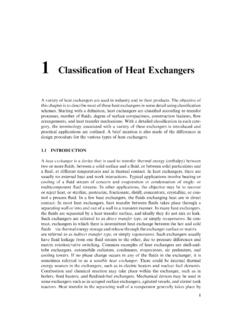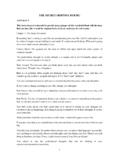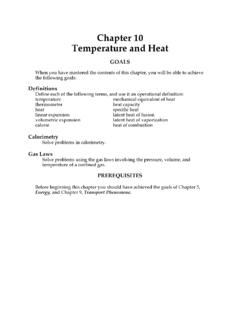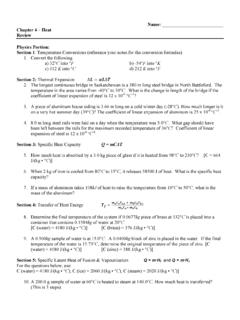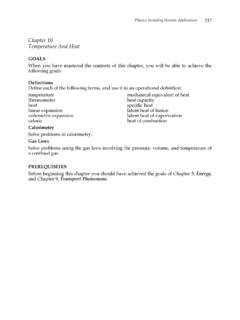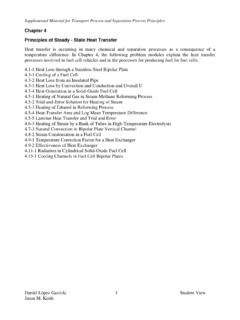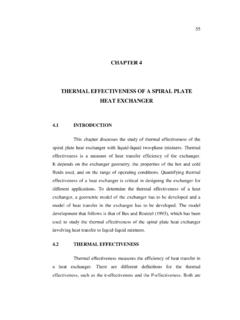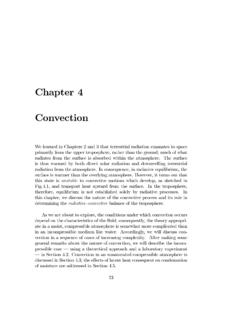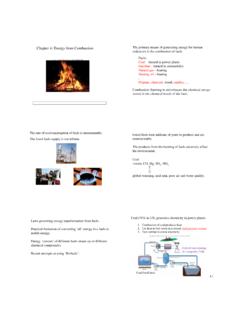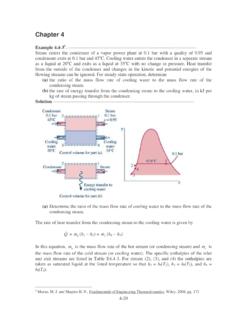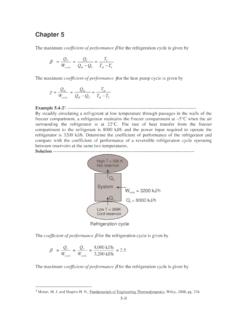Transcription of CHAPTER 4 DESIGN FUNDAMENTALS OF SHELL …
1 CHAPTER 4 DESIGN FUNDAMENTALS OF SHELL -AND-TUBE heat EXCHANGERS INTRODUCTION The thermal DESIGN of heat exchangers is directed to calculate an adequate surface area to handle the thermal duty for the given specifications whereas the hydraulic analysis determines the pressure drop of the fluids flowing in the system, and consequently the pumping power or fan work input necessary to maintain the flow. The most common problems in heat exchanger DESIGN are rating and sizing.
2 The rating problem is evaluating the thermo-hydraulic performance of a fully specified exchanger. The rating program determines the heat transfer rate and the fluid outlet temperatures for prescribed fluid flow rates, inlet temperatures, and the pressure drop for an existing heat exchanger; therefore the heat transfer surface area and the flow passage dimensions are available. The rating program is shown schematically in Figure [2] The sizing problem, however, is concerned with the determination of the dimensions of the heat exchanger.
3 In the sizing problem, an appropriate heat exchanger type is selected and the size to meet the specified hot and cold fluid inlet and outlet temperatures, flow rates, and pressure drop requirements, is determined. 70 Figure The rating program There are some criteria for a successful heat exchanger DESIGN . These principles are given below. [2] The process requirements which are accomplishing the thermal change on the streams within the allowable pressure drops, and retaining the capability to do this in the presence of fouling until the next scheduled maintenance period must be fulfilled.
4 The heat exchanger must withstand the service conditions of the plant environment. The exchanger must be maintainable. In other words, a configuration that permits cleaning and replacement of any component that is especially vulnerable to corrosion, erosion, vibration, or aging, must be chosen. The designer should consider the advantages of a multishell arrangement with flexible piping and valving provided to allow one unit to be taken out of service for maintenance without disturbing the rest of the plant.
5 The heat exchanger should cost as little as possible provided that the above criteria are satisfied. Limitations on the heat exchanger length, diameter, weight, and/or tube specifications due to site requirements, lifting and servicing capabilities must be all taken into consideration in the DESIGN . There are some terms used in heat exchanger specification problems and their solutions, which are often confused. These are rating , DESIGN , and selection . Rating is the computational process in which the inlet flow rates and 71temperatures, the fluid properties, and the heat exchanger parameters are taken as input and the outlet temperatures and thermal duty (if the exchanger length is specified) or the required length of the heat exchanger are calculated as output.
6 In either case, the pressure drop of each stream will also be calculated. DESIGN is the process of determining all essential constructional dimensions of an exchanger that must perform a given heat duty and respect limitations on SHELL -side and tube-side pressure drop. A number of other criteria are also specified, such as minimum or maximum flow velocities, ease of cleaning and maintenance, erosion, size and/or weight limitations, tube vibration, and thermal expansion. Each DESIGN problem has a number of potential solutions, but only one will have the best combination of characteristics and cost.
7 Selection means choosing a heat exchanger from among a number of units already existing. Typically, these are standard units listed in catalogs of various manufacturers. Sufficient manufacturer s data usually exist to allow one to select comfortably oversized exchanger with respect to both area and pressure drop. For the present CHAPTER , Kern and Bell-Delaware methods will be presented by performing Thermal Analysis and Hydraulic Analysis separately for the tube-side and for the SHELL -side.
8 The rationale behind these choices is that the Kern method offers the simplest route and the Bell-Delaware method offers the most widely accepted method. KERN METHOD The first attempts to provide methods for calculating SHELL -side pressure drop and heat transfer coefficient were those in which correlations were developed based on experimental data for typical heat exchangers. One of these methods is the well-known Kern method, which was an attempt to correlate data for standard exchangers by a simple equation analogous to equations for flow in tubes.
9 However, this method is restricted to a fixed baffle cut (25%) and cannot adequately account for baffle-to- SHELL and tube-to-baffle leakages. However, although the Kern equation is not particularly accurate, it does allow a very simple and rapid calculation of SHELL -side coefficients and pressure drop to be carried out 72and has been successfully used since its inception. [1] Since Delaware method is a rating analysis, first Kern method is used to estimate the size of the heat exchanger for a given specification.
10 Thermal Analysis for Tube-Side Number of Tubes The flow rate inside the tube () is a function of the density of the fluid (tm t ), the velocity of the fluid (u), cross-sectional flow area of the tube (), and the number of tubes (). [4] tcAtN ( ) NAtctttum = By using Eq. ( ) and replacing by , number of tubes can be calculated as cA4/2id ( ) 24ittttdumN = where is the tube inside diameter. id Tube-Side Reynolds Number The criterion of distinguishing between laminar and turbulent flow is the observed mixing action.
